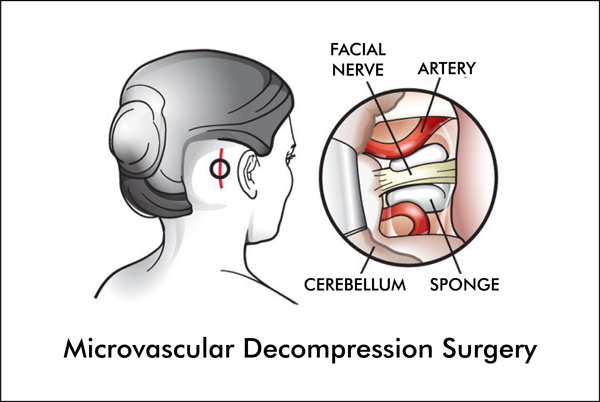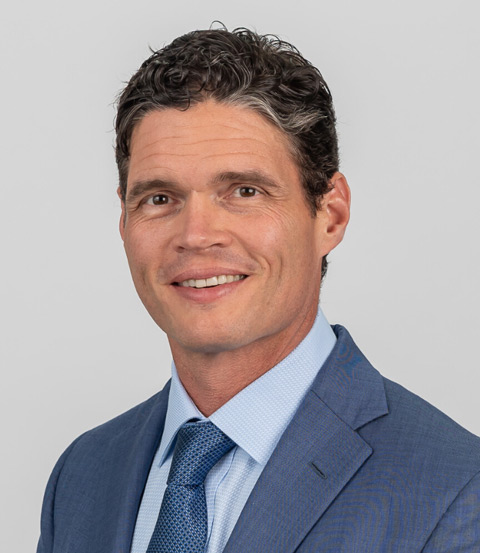
Hemifacial spasm is a rare neuromuscular disorder affecting only about 11 in every 100,000 individuals. For most patients, a displaced blood vessel compresses the facial nerve. Compression of the facial nerve causes misfired nerve signals, which results in facial spasms.
Would you like to request a hemifacial spasm consultation?
Hemifacial spasm diagnosis
Physicians diagnose hemifacial spasm after discussing symptoms and ruling out any related conditions. Diagnosis should be made by a trained specialist. Neurosurgeons who specialize in the care and treatment of neuromuscular disorders may use imaging studies to diagnose hemifacial spasm and rule out other conditions. For example, they may use magnetic resonance imaging (MRI) to rule out tumors, blepharospasm, dystonia, seizures and other related conditions. Imaging tests are also useful in determining which blood vessel is compressing the facial nerve.
Unfortunately, some hemifacial spasm patients are misdiagnosed. Because hemifacial spasm is so rare, many patients receive misdiagnoses from medical providers or receive treatment for related conditions, such as Bell’s Palsy. Other rare disorders, such as trigeminal neuralgia, have similar symptoms and are also commonly misdiagnosed. In addition, many patients may not seek medical treatment for facial spasms after misdiagnosis or a lack of diagnosis from their doctor. Hemifacial spasm (twitches or contractions affecting one side of the face) should not be confused with blepharospasm (twitches or contractions affecting both sides of the face).
Hemifacial spasm treatment
Hemifacial spasm will not go away without medical intervention. After diagnosis by a specialist, patients may learn of multiple treatment options. Yet, it’s important to note that there is only one permanent treatment for hemifacial spasm: microvascular decompression surgery. Commonly, patients first try Botox after diagnosis.
Is Botox a hemifacial spasm treatment?
Botox has been shown to ease hemifacial spasm symptoms. These injections "freeze" the facial muscles by blocking nerve signals. However, Botox is not a permanent treatment. Most patients need several injections throughout the year, which can be costly and time consuming. Also, injections may stop working for some patients over time. Hemifacial spasm is a progressive condition, meaning it gets worse over time. As spasms increase in intensity and frequency, Botox injections can become less effective.
Microvascular decompression for hemifacial spasm
Microvascular decompression (MVD) surgery is the only known permanent treatment for hemifacial spasm. This specialized procedure relieves pressure on the facial nerve and targets the direct cause of spasms. Microvascular decompression is a minimally invasive procedure and only requires a small incision behind the ear. During MVD, the surgeon performs a craniotomy, or opening the skull, to access the facial nerve. After they locate the blood vessel compressing the nerve, the surgeon inserts a barrier or “sponge”-like material between the nerve and vessel. This restores normal nerve function to prevent the electrical misfires that cause spasms.
How successful is microvascular decompression?
Microvascular decompression surgery has a high success rate—over 90%. Patients usually experience relief from symptoms almost immediately after surgery. Some patients may experience a gradual decrease in spasms over time. Because the procedure is minimally invasive, recovery times are shorter than traditional surgery. This provides faster relief from symptoms. Most patients only spend one or two days in the hospital before discharge.
Any surgery has risks. Lasting or serious side effects from microvascular decompression are rare, but may include:
- Surgical infection
- Partial hearing loss
- Facial numbness or weakness (usually improves over time)
- Difficulty speaking or swallowing
- Stroke or bleeding (very rare)
Many patients find out about microvascular decompression surgery through their own research online. Hemifacial spasm is rare, and MVD is a highly specialized procedure, so not all referring providers are aware of this life-changing surgical option. Many physicians may prescribe Botox or other options before microvascular decompression because injections or other medications may temporarily ease symptoms. But, because hemifacial spasm is a progressive condition, only surgical treatment can provide permanent relief.
Do you have hemifacial spasm? Try our symptom checker.
Do you have hemifacial spasm? Try our symptom checker.

ABOUT DR. ULM
Arthur J. Ulm is a board-certified neurosurgeon who provides expert neurosurgical care for brain, spine and vascular disorders. During his microsurgical anatomy fellowship, he trained under the world-renowned neurosurgeon, Professor Albert L. Rhoton, Jr., MD, the pioneer of microvascular decompression surgery. MVD is the only known permanent treatment for hemifacial spasm. Dr. Ulm is one of the region’s leading neurosurgeons, with advanced training in hemifacial spasm treatment.
Dr. Ulm sees patients at Nashville Neurosurgery Associates. For more information, or to schedule an appointment, please contact us.

ABOUT DR. ULM
Arthur J. Ulm is a board-certified neurosurgeon who provides expert neurosurgical care for brain, spine and vascular disorders. During his microsurgical anatomy fellowship, he trained under the world-renowned neurosurgeon, Professor Albert L. Rhoton, Jr., MD, the pioneer of microvascular decompression surgery. MVD is the only known permanent treatment for hemifacial spasm. Dr. Ulm is one of the region’s leading neurosurgeons, with advanced training in hemifacial spasm treatment.
Dr. Ulm sees patients at Nashville Neurosurgery Associates. For more information, or to schedule an appointment, please contact us.
Want to know more about the causes and symptoms of hemifacial spasm?
CHARLIE JOE
Charlie Joe came to Dr. Ulm after diagnosis and unsuccessful treatment of his hemifacial spasms. After meeting and discussing his options with Dr. Ulm, Charlie Joe and his wife, Jane, decided he should have Microvascular Decompression Surgery, the only known permanent treatment for hemifacial spasm. Since surgery, Charlie Joe has been spasm free.
